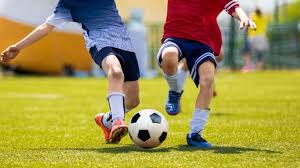Unlike previous ideas, stiffness harmonic code opens a new area in sports. In this case, sports harmonic code encompasses a broader set of ideas and includes some concepts from biomechanics, rhythm evaluation, and even algorithmic principles that seek to maximize movement execution together with other parameters of athletes’ performance.
By synchronizing bodily movements with the natural rhythms of the body, achieved through strech and contraction, fractal motors concept can be used which not only improves effectiveness but also decreases injury risks and enhances the overall athlete performance.
Comprehending Sports Harmonicode
Sports harmonicode pertains to the natural code or rhythm residing within an athlete’s movements, biomechanics, and timing. Like the analogy of harmonic codes in music and physics which deals with the existence of patterns and frequencies,
the aim of sports harmonicode is to achieve optimal bodily movements through the striking of their synergy. When athletes recognize and relate to their own personal harmonicodes, they can improve energy efficiency, coordination, and optimize athletic performance.
Read More: Advertise on FeedBuzzard.com | Unlocking Digital Advertising Success
Features of Sports Harmonicode
- Rhythmic Sequences: These are the elementary patterns of a body movement that become a basic feature of body activity rhythms. For instance, dribbling in basketball or a runner’s rhythm exemplify repetitive movements that when perfected, bring about enhanced coordination and performance.
- Melodies of Movements: This aspect of sports harmonicode accentuates the rhythmical movements skills that everybody uses during sports competitions or activities. It involves operational maneuvers, such as a golfer’s swing or a gymnast’s routine to the discipline, which involves movements with the harmonious bounded personal style.
- Harmony in Execution: It is the unison integration of rhythmic sequences and movement melodies so that everything works in complete coherence to each other. This harmony brings efficiency in energy expenditure, decreases chances of injury, and improves general performance.
Realization of Sports Harmonicode Strengths
- Realization of superior performance: Sports harmonicodes drive the aim of enabling an athlete to organize their movements according to the rhythms of their body which heightens the focus, improves the execution, and enhances results performance.
- Injury Prevention: By synchronizing a movement’s various components, harmonized movements mitigate undue muscle and joint strain, thus minimizing the possibility of injuries and extending an athlete’s career.
- Energy Efficiency: The optimization of energy efficiency in specific endurance sports comes as a result of improved stamina and recovery, which can be achieved through greater utilization of harmonicode.

Scientific Foundations
The development of sports harmonicode is primarily based on the biomechanics and kinematics. Biomechanics (a subdivision of physiology) studies the movements of the body in terms of energy efficiency and the form used.
Kinematics refers to the subdivision of dynamics that deals with the motions and movements of the body parts of an athlete performing a particular sport.
These knowledge areas give the athletes and coaches an understanding of how to adopt strategies and counter-measures in order to work on certain aspects in their performance.
Implementing Sports Harmonicode in Training
- Assessment: Use motion-capture systems and video stills to trace an athlete’s movement trajectory with an aim of ascertaining their motor skills and enhancing their flaws.
- Rhythm Training: Instill timing and rhythm emphasizing practices such as metronome motions or rhythmic drills particular to the sport.
- Functional Training: Focus on the natural harmonicode through plyometric and other functional sport-specific movements for enhanced athletic performance.
- Mindfulness Practices: Use body-centered breath stigma coupled with mindful activity to encourage awareness of one’s body and muscle movement patterns in tune with a given rhythm.
Practical Uses
Usain Bolt. The renowned sprinter is widely recognized because of his natural capacity to synchronize his movements with his body’s rhythms, enabling him to run in a manner that is remarkably fast and efficient.
Roger Federer. With graceful and fluid movements in the game of tennis, he displays the application of sports harmonicode which saves his energy during peak performance times.
Final Thoughts
Accepting the concept of sports harmonicode represents a revolution in thinking about a theory of athletic training and performance.
Sports harmonicode is designed to help athletes accomplish their best possible performance and reduce injuries and prolong their careers by appreciating and refining the natural rhythm and movements of each athlete.
The continued advancement of technology and sports science will lead to the application of sporting harmonicode principles into training regimes being a hallmark of outstanding sporting prowess.
Read More: Unlocking Athletic Performance: The Power of Sports Harmonicode
FAQs
What is sports harmonicode?
Sports harmonicode refers to the body’s natural rhythm and flow during movement. The athlete’s goal is to use the body’s efficiency patterns to manipulate their motor behavior and enhance performance.
How does sports harmonicode improve athletic performance?
Athletes who align physical movements to active bodily cycles can improve focus, coordination, and energy expenditure—yielding greater performance results.
What is the role of sports harmonicode in injury prevention?
Yes, the matching of motor actions and the biological rhythms of the body reduces unwanted stress on muscles and joints.
What measures can athletes take to apply sports harmonicode in their training?
Athletes can perform motion analysis, rhythm-based exercises, functional training, and engage in mindfulness to refine their harmonicoder.
Can sports harmonicode principles be observed in real life scenarios?
Certainly. Usain Bolt and Roger Federer are some of the few athletes who embody the principles of sports harmonicode.
